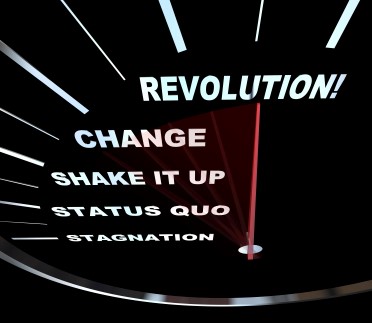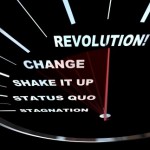
In an organisational context, revolutionary change is often about getting an organisation ‘back on the straight and narrow’. The goal of the change can manifest in many different ways, from a focus on cutting costs to ‘right-sizing’ a workforce, or entirely changing the space in which an organisation operates. Whatever the goal, revolutionary change involves a fundamental shift in the structure of the organisation, or the way in which it does business. Commonly, revolutionary change is thought of as being driven by external circumstances, but in my experience it is just as frequently driven by inadequate ongoing responses to emergent internal circumstances.
When revolutionary change is measured, many organisations believe that measuring whether or not the change has occurred is sufficient. My observation is that even when the change has occurred—as measured by an often-opaque set of performance indicators—the collateral damage caused by unintended consequences far outweighs the benefit gained from implementing the change in the first place. A significant cause of those unintended consequences during revolutionary change is limited and/or poor communication. This article seeks to give you a toolbox of communication channels for revolutionary change.
It is axiomatic that revolutionary change results in a majority of people going through the classic psychological reactions to change (see below).
The key objective, then, in communicating during revolutionary change is to provide certainty. Most people can cope with disappointment; what they cannot cope with is ambiguity.
It’s not uncommon for project teams and change leaders to want to withhold information during revolutionary change. Questions about what the workforce will think or how the unions or media might react lead the decision-makers to keep things to themselves, and this is prudent while the goals and nature of the change are being debated and decided. However, when it’s time for the rubber to hit the road and implement the change, withholding information only adds to the anxiety people feel.
This manifests in two ways:
- After communication begins, whatever residual trust remains withers even amongst the supporters of the change, as they feel they are not being trusted with the full information.
- A rush of misinformation and rumour swamps the vacuum formed by the absence of official information.
In evolutionary change, the objective is to engage people through the phases of:
- Understanding
- Belief and acceptance
- Caring
- Planning
- Implementing.
In revolutionary change, we concentrate on the first two phases and drive through the last three phases top-down, taking as many people with us as we can, but not relying on people being truly engaged to complete the change. Revolutionary change is best done the same way you take off a band-aid—quickly, and with determination. Doing so any other way permits the agenda of the change to be subverted by interest groups with their own view of ‘how things should be done’.
In the second stage, the belief and acceptance we seek from employees is that the change will happen, rather than that the change is good for them. Of course, we want as many people as possible to believe in the change, but as time is of the essence, this is not necessarily the priority; managing revolutionary change over a too-long time period does not turn it into evolutionary change, it simply intensifies and prolongs the anxiety experienced by those whom the change affects.
Communication Channels
Any communications strategy developed to help managers and team leaders through these stages of engagement should consider the channels to be used in communicating the content.
For the purposes of this article, I have broken these channels down into four broad groups:
- Face to face, where individuals or groups assemble in the same place at the same time to have a one-way conversation (e.g. a presentation) or a two-way conversation (e.g. a workshop).
- Audio-visual, where individuals need not be in the same place at the same time, but a combination of video or sound is used.
- Social media, channels designed to promote highly accessible interactive dialogue on a topic.
- Text-based, where communication is chiefly performed by the written word (whether or not accompanied by pictures, diagrams etc.)
Face-to-Face Channels
Presentations
In revolutionary change, it is mandatory that the most senior person in the organisation be present to communicate the change to staff. The people most affected by the change must be able to see and hear the genuine need for this change by being able to observe the body language and tone and pace of voice of the most senior person driving this change.
Here is a simple tip: if you are ever in that situation—where you are the most senior person in the organisation—and you do not actually believe in the change, get out of that metaphorical kitchen. The incongruence between your body language, tone and pace of voice and your words will be palpable and your words will sound like weasel words.
When creating the presentation, keep three things in mind:
- Use a symbol to communicate the change
- Use data to back your words
- Speak with passion.
A symbol may be a logo, a catchphrase, an image or a range of modelled behaviours and actions. When John Fletcher took over as CEO of Coles Myer—as it was then—he turned over space on the top floor of the building at Tooronga, which his predecessor kept as his fiefdom, to general office space leaving himself a good working space and saving the company hundreds of thousands of dollars per annum in rental at other buildings. That move was a powerful symbol that life had changed at Coles Myer. The nickname of ‘Battlestar Galactica’ for the head office building soon disappeared.
It is fine to make assertions about the problems your organisation faces but if they are not backed up by data, they become less believable. Clearly, you will not have embarked upon revolutionary change without good data to support your decisions. Trust your people—all of your people—to understand and interpret the data. Providing people with the data upfront helps them both understand and believe in the change and provides a benchmark upon which to report on the success or otherwise of the change as time goes by.
Nothing, and I do repeat, nothing trumps speaking with passion to get people to believe. It has been the hallmark of despots and evangelicals alike in getting their followers to believe. It is important that you, as a leader, learn to reframe your messages of change into something that you do believe in and that your audience will understand so that your passion will be natural, not forced.
Speaking with passion invokes all three communication cues taken by people to determine if are genuine; your words (the least important), your tone and pace of voice, and your body language (the most important).
Think of some of the poor communicators we have in our political world now.
Julia Gillard and Tony Abbott both lack passion when they talk although Julia does slip up occasionally and speak with passion, particularly if it is about education. Both of our political leaders rely too heavily on phrases word-smithed until devoid of all meaning, chanted like some mantra to the waiting 24-hour news cycle. Barack Obama, on the other hand, can often reframe even the most mundane topic into something he is passionate about, and consequently comes across as more believable than if he stuck with the monotone catch-phrases and bureaucratic doublespeak of his Australian counterparts.
Presentations are useful in the following stages of engagement:
- Understanding: a presentation by senior management is mandatory in revolutionary change. The key task is to get people to understand that the change is going to happen and what the timeline of events is. It is important to communicate the ‘why’ of change, but do not expect to convince all people on that count. Senior executives must be seen to be willing to look people in the eye with what most will see as bad news.
- Belief & Acceptance: follow up the initial presentation with regular appearances updating the progress and plans. It is important that the chief executive is supported by the rest of the executive team in being consistent, insistent and persistent about the messages of change and progress. Create presentation packs for all executives to use to ensure a consistent message. Due to the speed and scope of revolutionary change, it is difficult recover from a communication misstep, so do not leave gaps in the information flow, as they will quickly be filled by rumours. It is important that senior managers, when they do not know the actual future timeline of change, talk about the process to determine the exact changes required. In revolutionary change there is less scope to involve people in the ‘how’ of the change, but the more that this can be done within the timeframes necessary, the more likely the change is to be accepted. However, be aware that many people will see being told they have no choice over the change but can determine how to implement the change as being disingenuous. In some cases it may be better to direct the how of change too.
- Implementation: presentations by executives throughout the implementation phase can help people to understand that executive determination extends into driving the implementation itself.
Feedback and support
Alongside the structured aspects of a communications strategy, more fluid elements can serve an important role in filling gaps and embedding change into the day-to-day activities of the business. Feedback and support can be used in the following ways:
- Understanding: provide trained people—preferably supervisors—to collect and give feedback to people on the change. When a revolutionary change is announced, the senior executives making the announcements can quickly become targets of ire and derision for many people; which means they stop listening to what the executives have to say and rely instead on their own preconceived notions of what the change is about. People need someone they can turn to correct misconceptions and answer questions away from the glare of public presentations.
- Belief & Acceptance: don’t be surprised if revolutionary change causes grieving similar to that experienced with a bereavement. Expect the need to provide counselling on different levels. At one level, counselling comprises pragmatic help such as how to find a new job, how to manage the financial windfall of a redundancy to reap the maximum benefit, or how to learn new skills to aspire to new jobs within the organisation. On another level, counselling can comprise helping people over their particular grief about a specific and personal impact of the change. Do not discount these actions as not being relevant to communication. To the individuals involved, they communicate something quite personal, but to the masses they communicate that you care and, in doing so, help embed belief in the change.
Workshops
Workshops—as distinct from meetings, seminars and presentations—are designed to promote the free exchange of ideas and two-way communication between individuals and groups. Some may not regard workshops of this kind as part of a communication strategy. They are working from far too narrow a definition of what to include in a communication strategy and may be missing a very important planning and design activity in designing the workshops to achieve maximum understanding of the goal of the change.
Workshops, in revolutionary change, are useful in the following stages of engagement:
- Understanding: conduct Analytical Workshops involving managers, team leaders and subject matter experts across business units in your organisation to analyse the impact of the change on their business units and the necessary actions to be taken. This provides an active learning experience which will provide a good understanding of what needs to happen and will surface risks which may create unintended consequences. It also serves to create an environment of being involved in doing something about the change rather than being always subject to the change. Some people, hopefully a large minority, will feel that they have some power and control back, which they tend to lose after the announcement.
- Caring: provide team support to those having difficulty with the change to get them to focus on what they can influence during the change. Run coping with change workshops which cover:
- The nature of change (theory of change applied to their personal experiences of change)
- How change affects individuals
- Strategies for coping with the change they are undergoing
- Developing resilience to the change they are undergoing
- Helping people cope with change in this practical way will help them through their phases of reaction to change faster and will allow them to more positively care about the change faster. Provide leaders with a similar workshop but with an emphasis on leading change. Content may include:
- Theory of change
- Leading yourself through change with particular emphasis on this change
- Leading others through change with particular emphasis on this change
- Practicing change conversations for this change
- Running both workshops will give leaders and their direct reports the same lexicon in which to discuss the change. A common language to discuss analysing how the change impacts on people, the skills necessary to work with the change, and the actions which can be taken, reduces angst by making people feel they are part of a team undergoing change rather than an individual.
- Planning: hold Planning Workshops with managers and their teams to plan how to implement the change in their business unit. Your role here is to be more directional than in the case of evolutionary change. Give the team the milestones and outcomes required but allow them to work out dependencies and resource requirements. It may be the case in some examples of revolutionary change that you will need to form a tight knit group of managers and senior supervisors and analysts to complete the planning without involvement of the broader workforce. This is undesirable but sometimes necessary in revolutionary change when time is short and the broader workforce is still dealing with grief. In this case, plan using a smaller team and give the broader workforce an opportunity to comment on the plan.
- Planning: use Risk Management Workshops to flush out hitherto unforeseen risk events, the consequences of which if the event is realised, could derail the change. Assist the business unit planning teams by facilitating the workshop providing insights into risk events they may not have thought of. Allow them to determine the likelihood and consequence using facilitative questioning to test their assumptions. Decide, based on the nature of the risk and the urgency of the planning whether to allow them to also determine whether they accept or reject the likelihood and consequence of the risk events unless the risk is beyond what the project or organisation is willing to generally bear.
- Planning: use Stakeholder Management Workshops at the organisational level—and at the business unit level if required—helping you determine who you need to influence. You will need to identify those individuals with high power to affect the outcome or direction of the change programme, and determine how to move those who exhibit active or passive resistance to at least a neutral stance, and passive supporters to active supporters.
Audio-Visual Channels
Video
There is little substitute for a personal appearance to announce what is taken as bad news. People must be able to not only here and see the whole message, they must be able to have a two way communication lest they misinterpret, distort and replace your messages. So, video is not really a suitable communication channel, it being preferable to use web conferencing as it enables that two-way communication.
Web Conferences
A web conference—or related technology like video conferencing—enables face-to-face-like interactions over distance, and is especially useful for organisations with a geographically dispersed workforce. It is generally insufficient, however, to use web conferencing and similar technologies as a means to deliver a one-way lecture.
Ways in which this technology can be used to gain engagement are as follows:
- Understanding: if your workforce can’t be gathered in one place, you can use video conferencing and on-camera webinars to make a simultaneous announcement about change across several locations. This Is not, however, a substitute for a personal appearance; ensure that dates for follow-up personal visits are known and are communicated as part of the web conference. Ensure also that the agenda is set and agreed to well before beginning the conference/webinar.
- Further web conferences may be used as follow-up meetings to clarify misunderstandings and communicate progress on issues. In follow up meetings create activities that are designed to engage the audience to ensure they understand by making use of the functionality of web conferencing software including but not limited to:
- Slide show presentations
- Live or Streaming video
- Meeting Recording for later viewing and/or distribution.
- Whiteboard with annotation allowing the presenter and/or attendees to highlight or mark items on the slide presentation
- Text chat for live question and answer session
- Polls and surveys
- Screen sharing/desktop sharing/application sharing
- Caring: use web conferences for updates and making sure people are aware who is making progress and who needs help and potentially connecting those people together. Use project team members, human resources and executive management for question and answer questions around the need for the change and the commitment of the organisation to make it happen.
- Implementation: use web conferences to help create a positive environment for lessons learned across the organisation.
Social Media Channels
Applications like Yammer, Telligent Enterprise and Chatter have been slowly reconfiguring corporate expectations since not long after the turn of the millennium. Nowadays, with more than 80 percent of the Fortune 500 using Yammer alone, enterprise social networks are no longer a new-fangled idea—indeed, they can be powerful communication tools when used effectively, being great for both synchronous and asynchronous engagement. They also allow unfiltered feedback to be gathered, with analysis of that feedback then being used to inform any redesign of communications tactics or content.
This is not to say that older technologies, such as the corporate intranet, blogs, wikis, discussion forums and the like can’t still be useful.
Social media channels are best used in revolutionary change as a means of getting feedback and broadcasting what the timeline of activities and milestones are and to provide ready answers to people’s questions. Ways to use social media channels to gain engagement in a revolutionary change include:
- Understanding:
- Use your intranet as a broadcast medium for developing understanding of a change—as long as it is informative and capable of a degree of interactivity. Using the intranet as a one-way channel to help improve understanding is to underutilise the medium. Means of making the intranet more interactive include:
- Frequently Asked Questions
- Downloadable checklists
- Where to go to get help or counselling
- Where to go to apply for redundancy, if this is applicable
- Use enterprise social networks to get feedback on the change through all stages of engagement. Ensure that you have staff available to monitor and reply to threads of conversation as they develop
- Discussion forums or “bulletin boards” are among the oldest collaborative tools, and still very useful for sharing and discussing ideas around a particular topic.
- Use your intranet as a broadcast medium for developing understanding of a change—as long as it is informative and capable of a degree of interactivity. Using the intranet as a one-way channel to help improve understanding is to underutilise the medium. Means of making the intranet more interactive include:
- Belief & Acceptance: social media channels, where they already exist in your organisation, will be used to form beliefs, regardless of whether you are involved or not. It is better that you provide information and insight into those channels by way of constant updates on progress, asking opinions and answering questions—preferably before they have been asked—by means of constantly updated frequently asked questions. Delegate leadership of discussions and activities to people in the organisation who “get” the change, but have an independent mind and status within the organisation. This is so that discussions are not seen to be propaganda.
- Caring: social media channels may be either a driver of increased caring or a rapid means of spreading negative feelings and ambiguity about the change. Their use will magnify the impact of your change management efforts. Controlling them heavily has a negative impact. They are unlikely to be suitable for getting people to care about a revolutionary change because of the risk.
- Planning: Use enterprise social networks to get quick feedback on plans. Feedback may be sought from within a team or across business units. Use wikis to create planning documents, but use a moderator well versed in the project and with good project management skills to oversee the content build up.
- Implementation: Use enterprise social networks to get quick feedback on implementation successes and issues. As a discussion leader, use a person who believes in the change and is experienced in all aspects of the engagement process to date, from understanding to planning.
Text-Based Channels
There is a wide variety of text-based channels available, with each serving a specific purpose:
- One-way emails are great for quick, simple communication that is not liable to be misunderstood.
- Two-way emails are a cheap and quick means of holding an asynchronous discussion where deep understanding and questioning is not required.
- Brochures are good for providing a brief overview of a topic using pictures or diagrams.
- Newsletters are one-way static communications that could be either paper- or electronically-based. Only newsletters with a high circulation and readership are useful as communication tools.
- Desktop guides—being typically a more in-depth, lengthier and more structured view of a topic than a brochure—are good for relaying complex information that is easily organised into sections.
- How-to guides are similar to desktop guides but tend to give more direct instruction.
With the object of communication in revolutionary change being to generate certainty instead of ambiguity, the next best thing to a personal appearance by senior management for a two way conversation for people undergoing the change is to get something in writing.
Our recommendations on the use of text-based channels in engaging the workforce during revolutionary change are:
- Understanding: to understand a change, people need to be able to question, paraphrase and summarise. For this reason, text-based channels—especially those that are one-way—tend to be less suitable. Emails are suitable for confirming when a face-to-face communication is about to occur. They are not suitable for announcing revolutionary change. Emails may be suitable for confirming what is intended and what the process is for progressing the change, although please remember that people have different communication preferences and other text based channels should be used concurrently. For example, use message boards, printed hand-outs and personal letters to confirm what is happening and what is going to happen. Brochures can be effective because they are in a different form to most corporate communications and they stand out from the daily clutter. However, it is our recommendation not to use brochures during revolutionary change. They have a tendency to look too slick, too corporate and too impersonal. Internal newsletters are effective means of improving understanding if they have a wide circulation and are widely read; survey the distribution and readership of your internal newsletter to comprehend how useful it may be. Newsletters with high readership levels are better though, for gaining belief.
- Belief & Acceptance: internal newsletters, especially if articles are written either by senior management or by people being affected by the change, can be very useful for developing belief. Try to avoid articles written by the project team, as they are always seen as having a vested interest. The best subject-matter for text-based channels at this stage of engagement is the case study, showing how the change has been beneficial in other contexts.
- Caring: use emails to give feedback and to advise of timelines. Use them also to announce the help that will be available in terms of counselling and outplacement (if necessary) and for planning and implementation to make the activities required to action the change appear less involved and time-consuming. Internal newsletters are quite useful in getting people to care enough to prioritise. Use internal newsletters to spread stories of early adoption and success. Provide public praise especially for teams rather than individuals.
- Planning: Use emails only for communicating simple information including known timelines, risk events, resource constraints. If planning is reasonably complex consider creating some how-to guides with the negotiable and non-negotiable clearly identified. Also consider how-to guides on completing process analysis and re-engineering processes if these activities are involved in the change.
- Implementation: Use emails only for communicating simple information including implementation timelines, resource availability and templated feedback. Typically, any implemented change will generate a number of new process and procedure documents that explain the details of the change and how it is meant to work. If you want your workforce to really be engaged with the implementation, though, consider the use of desktop guides or how-to guides as an expansion on that material that is not restricted by the template requirements of formal procedure documentation.
Choosing the appropriate mix of communication channels for your change programme environment and your organisation’s culture is obviously not a simple task. Designing the content also takes skill and experience. We can help to reduce the unintended consequences of revolutionary change by helping you to avoid communications that don’t have the desired impact. Change Factory can help you make those choices and design the content, making change easy.
You may also be interested in the article: Communication choices during Evolutionary Change







